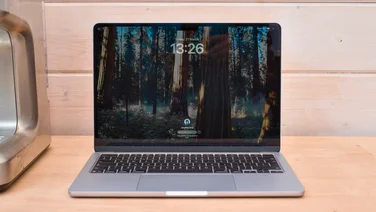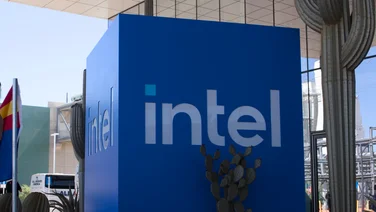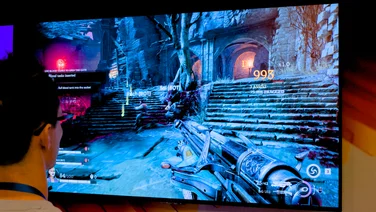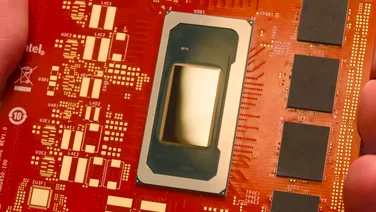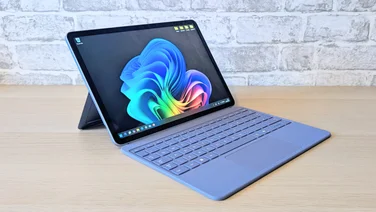To help us provide you with free impartial advice, we may earn a commission if you buy through links on our site. Learn more














- Colourful 120Hz AMOLED touchscreen
- Good value with the current £200 discount
- Two 2280 SSD mounts
- Design lacks flair
- Disappointing battery life
- Mediocre webcam
Samsung might be considered a stalwart of the laptop market, but it’s a relatively recent arrival, thanks to a six-year hiatus between 2014 and 2020, when it completely withdrew from the European PC market. Since its return, however, its laptops have consistently impressed, and the Samsung Galaxy Book5 Pro is its latest model.
Just recently, we’ve been a little disappointed in the lack of adventurousness, particularly in the design department. Stagnation is perhaps too strong a word to describe this, but the improvements have been more subtle than dramatic and that, unfortunately, also applies to this particular laptop.
Samsung Galaxy Book5 Pro review: What you need to know
Other than the introduction of Intel’s latest Series 2 Core Ultra processors, what we have here is another cautious – some might say overly-cautious – evolution of the designs we’ve become familiar with over the last couple of years.
The Pro models, of which this is one, are the bread-and-butter of Samsung’s laptop range, targeted at professional as much as casual users, and for 2025 the basic Pro model is available in both 14in and 16in guises.
The Galaxy Book Edge models, which run on Qualcomm Snapdragon processors, and the Galaxy Book Ultra machines that feature discrete Nvidia GPUs, and the entry level Galaxy Book4 are currently only available in their 2024 iterations.
Price and competition
4.8Ghz 8-core Intel Core Ultra 7 256V CPU, 16GB RAM, 512GB SSD, 14in 2,880 x 1,800 AMOLED 120Hz display. Price when reviewed: £1,299
The price of the Galaxy Book5 Pro is a bit of a movable feast, thanks to Samsung offering discounts on various iterations. The 512GB SSD, 16GB RAM 14in model with the Intel Core Ultra 7 256V is currently on offer for £1,299 down from a regular price of £1,499. The 16in version is on sale for £1,399 down from £1,599 and opting for a 1TB SSD ups the price by a borderline extortinate £200.
If you want the Intel Core Ultra 258V, which comes with 32GB RAM on the CPU, you can currently only have it the 14in model with a 512GB SSD and Windows 11 Pro. That model costs £1,649.
- My favourite compact laptop by some margin is the Asus Zenbook S14. It’s achingly pretty, has a glorious 2.8K 120Hz OLED screen and good battery life and costs £1,149 from Amazon for a better specification than the Book5 than the . If you want a 16in laptop, the AMD-powered Zenbook S16 is just as easy to recommend. Right now, you can buy the Zenbook S16 from Asus for just £1,199.
- Lenovo’s Yoga Slim 7i Gen 9 Aura Edition has a 15.3in screen, so it sits nicely between the 14in and 16in competition. The display is a seriously bright 2.8K IPS affair that’s both colourful and accurate. Being a Lenovo, the keyboard is beyond reproach. Spec for spec, the Lenovo matches the Samsung for price at £1,299.
- The epitome of compact laptops, the Apple MacBook Air, now has M4 power, and with prices starting at £999 for the 13.6in model and £1,199 for the 15.3in version, it’s quite the value pick if you can live with a small 256GB SSD. Apple and Samsung both think it’s reasonable to ask for £200 to double the SSD capacity. It isn’t.
- First fruit of Dell’s range overhaul, which will see the end of the Inspiron, Latitude and XPS lines, the Dell Pro 13 Premium is a smart and well-made 13.3in laptop with a fine XPS-like keyboard, an excellent webcam and long battery life. The display, though, is rather basic given the high price; the range starts at around £1,700.
Design and features
Before starting this review, I checked back on some previous Galaxy Book kit I’ve looked at and chanced upon my review of the first Galaxy Book Pro. It was a stunning all-white machine that weighed only a little over 1kg.
The 2025 model weighs a bit more 1.23kg and comes in grey. And that’s exactly how Samsung describes it on its website: grey. Last year’s 2024 machines are available in Moonstone Grey or Platinum Silver, a description that at least give the impression the design department is trying. Only the prismatic logo on the lid adds visual flair to the 2025 model.














Dowdy aesthetics aside, the all-aluminium Galaxy Book5 Pro is a solid and well-made laptop and despite its MacBook Air-esque 11.6mm profile, comes with a satisfactory array of ports and sockets with two Thunderbolt 4 ports and an HDMI 2.1 output on the left and a USB 3.2 Gen 1 port, a 3.5mm audio jack and MicroSD memory card slot on the right. A second, and faster, USB-A port wouldn’t have gone amiss, but what you get here is good enough.
Wireless communications are managed by the ever-reliable, and fast, Intel BE201 card that supports the latest Wi-Fi 7 and Bluetooth 5.4 standards.
To get inside the Galaxy Book5 Pro you have to prise the four rubber feet off, undo the Philips screws beneath them and carefully unclip the plastic base. Once in, you’ll notice not one but two M.2 2280 SSD mounts, which is an unusual feature for a 14in ultraportable.














Poking around the internals, the battery looks like it will come away without drama and the same can be said of the two fan guards. It all bodes well for routine maintenance.
The 512GB Samsung SSD in my machine returned average sequential read and write times of 4,033MB/s and 2,614MB/s respectively, which is just a nose ahead of class-average.
This being a Samsung laptop, it’s loaded to the gunwales with Samsung apps, which may or may not come in useful, depending on how many other Samsung gadgets and devices you own. Of the dozen-plus apps pre-installed, the AI-assisted image gallery was the only one I returned to.














Keyboard, touchpad and webcam
Samsung’s laptop keyboards get a fair amount of flak for being rather shallow, and things are no different with the Galaxy Book5 Pro. The chiclet keys have a crisp action and a precise end-stop, but the amount of travel is certainly on the low side.
The layout is conventional, and, notwithstanding the half-height cursor keys, I had no issues with it. I don’t like fingerprint scanners to form part of the keyboard matrix, or to be integrated into the power button, but I’d be lying if I said this caused me any problems Elsewhere, the keyboard does its job perfectly well. The white-on-black keycaps are very clear and easy to read, and the three-stage white backlight does a great job, no matter the ambient light level.
At 115 x 85mm, the mechanical touchpad is more than large enough for grand gestures, and the surface is very smooth. The click-action is crisp and positive, if a little on the loud side.














Samsung boasts that the touchpad features something called “adaptive palm rejection”, which monitors different parts of the trackpad to eliminate accidental touches, but I can’t say as I noticed any difference over a standard Windows Precision touchpad.
The 1080p webcam isn’t particulary impressive, however: it’s a basic affair that’s dull, and not particularly sharp. According to Samsung, the webcam uses “Staggered HDR”, which makes webcam video “crisp and vivid with a wide dynamic range”. I saw no evidence of that in my testing and it’s a million miles away from the high-quality webcams you’ll find on a MacBook Air or a Dell Pro 13 Premium. There’s also no support for Windows Hello IR facial recognition, which feels like a major omission on a laptop costing well over £1,000.
Display and audio quality
Samsung can always be depended on to deliver a quality OLED display and the Book5 Pro’s is no different. Its 2.8K 14in screen is very crisp. It has a MacBook Air-beating pixel density of 243ppi and, being an OLED panel with a variable 120Hz refresh rate, motion is baby oil-smooth.
The display is not super-bright but, rather, par for the OLED course, hitting 391cd/m2 with standard dynamic range content and 571cd/m2 full-screen in HDR mode (it is certified VESA True Black HDR500), but that is more than enough to combat any reflections from the high-gloss finish in most lighting conditions.














And, as you’d expect from an OLED screen, the display supports wide colour, and in testing I found it was capable of reproducing a maximum of 116.8% of the DCI-P3 colour space (equal to 164.8% of sRGB and 113.6% of AdobeRGB). In the Samsung settings app, you can choose from three factory calibrated profiles targeted at these colour spaces and all three are very accurate. In my tests, I recorded average Delta E variances of 1.09 (sRGB), 1.25 (AdobeRGB) and 0.9 (DCI-P3) against those three colour profiles.
Elsewhere, it’s good to see that Samsung has not deprived its Pro machines of a touchscreen in order to drive customers towards the more expensive Galaxy Book 360 convertible models, and the glass screen is a joy to use, reacting perfectly to taps and swipes.














The audio output is pretty good, too. Buried inside the chassis are four speakers: two 5W woofers and two 2W tweeters. The sound these produce is very detailed and forward, but given the on-paper specification I expected rather more volume and more bass. I recorded 72.9dBA from a pink noise source at 1m, which isn’t bad, but it won’t have the neighbours complaining.
Performance and battery life
By way of a reminder, the Core Ultra 7 256V inside the Galaxy Book5 Pro is an octa-core chip with four performance cores, four efficiency cores and a maximum turbo clock speed of 4.8GHz. It’s backed up by 16GB of built-in LPDDR5X memory and a 1.95GHz integrated Intel Arc GPU.
The new Samsung topped the Core Ultra Series 2 performance charts in our multi-media 4K benchmark, which was an impressive showing given that it was up against machines with CPUs that were marginally faster on paper and had more RAM.
Other benchmarks didn’t show this advantage as clearly, if at all, but that doesn’t mean that the Galaxy Book5 Pro isn’t a very handy performer and up with the very best of the Core Ultra Series 2 cohort. It absolutely is.
Graphics performance from Intel’s Arc integrated GPU continues to impress: The Galaxy Book5 Pro ran the SPECviewperf 3dsmax modelling benchmark at 25fps and played the 2016 Doom reboot at a comfortable 60fps at Full HD with high detail enabled, although the touchpad did get rather warm after half an hour of gameplay.
In the Geekbench 6 GPU OpenCL benchmark and GFXbench tests (charts above) it returned solid scores, but it does lag behind the competitors I’ve selected here. That’s principally due to it having 16GB of RAM, though, than any lack of raw performance, as it has the same integrated Arc 140V graphics silicon as its Windows rivals.
It’s indicative of how times have changed recently that the Samsung Galaxy Book5 can run for nearly 16 hours on battery, much the same as a MacBook Air, but still be described as a mediocre performer. That’s because the likes of the Dell Pro 13 Premium can go for five hours longer, and some Snapdragon-powered Windows machines like the Acer Swift 14 AI can run for a full 24 hours on a charge.
I appreciate that a 2.8K OLED screen is not the most power-efficient option when it comes to laptop displays, but the Asus Zenbook S14 managed to chug along for nearly 18 hours and a half hours, and it also has a 2.8K OLED screen. Given Samsung’s 63Wh battery – admittedly smaller than the Zenbook S14’s 72Wh – I expected better.
Samsung Galaxy Book5 Pro review: Verdict
The current £200 discounts Samsung is offering on both the 14in and 16in Galaxy Book5 Pro models make them good value, and both machines have their strong points, primarily their high-quality 2.8K AMOLED touchscreen displays, good performance levels and ability to accommodate a second SSD.
In the glass-half-empty column, the design is rather stale and uninspired, the webcam is subpar, the keyboard shallow, and the battery life is not on par with the competition.
Given the intensity of the competition in this part of the laptop market, it’s difficult not to think that Samsung should be trying just a wee bit harder.














Samsung Galaxy Book5 Pro Specifications
| Processor | Intel Core Ultra 7 256V |
| RAM | 16GB |
| Additional memory slots | No |
| Graphics adapter | Intel Arc Graphics 140V |
| Graphics memory | Shared |
| Storage | 1TB |
| Screen size (in) | 14 |
| Screen resolution | 2,880 x 1,800 |
| Pixel density (PPI) | 242 |
| Screen type | OLED 120Hz |
| Touchscreen | Yes |
| Pointing devices | Touchpad |
| Optical drive | No |
| Memory card slot | Yes |
| 3.5mm audio jack | Yes |
| Graphics outputs | Thunderbolt 4 x 2, HDMI 2.1 x 1 |
| Other ports | Thunderbolt 4 x 2, USB-A 3.2 Gen 1 |
| Web Cam | 1080p |
| Speakers | Stereo |
| Wi-Fi | Wi-Fi 7 |
| Bluetooth | Bluetooth 5.4 |
| NFC | No |
| Dimensions (mm) (WDH) | 312 x224 x 12 |
| Weight (kg) – with keyboard where applicable | 1.23 |
| Battery size (Wh) | 63 |
| Operating system | Windows 11 Home |


